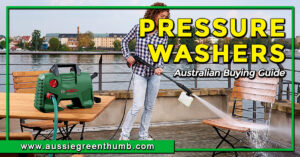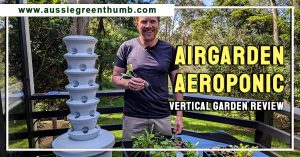Grow light stands and shelves are a real boon for those of us gardening in tight spaces, maybe without greenhouses, or possibly without an outdoor garden space at all. As our world becomes smaller, and gardens get less common, it’s essential that we maintain our ability to grow our own food or support our house plants at home.
Gardening is, perhaps, no longer the norm for many Australians, but it’s an essential piece of the wellbeing puzzle. So, even if you have no outdoor space to grow, get yourself a good-looking indoor grow light shelf or stand, set it up with your favourite houseplants, and find time in your life for greenery. It’ll be worth it!
More...
Top Pick

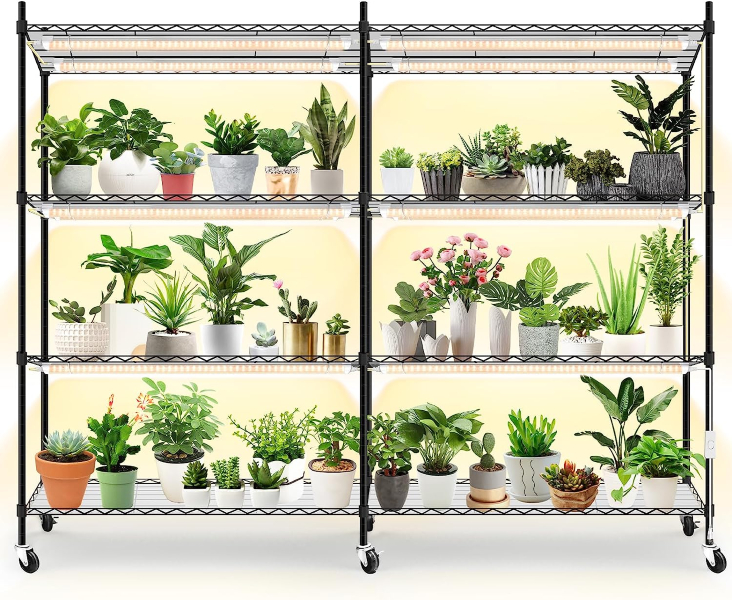
Best Value


Product | Our Rating | Price | |
|---|---|---|---|
1. Bstrip 4-Tier Grow Light Shelf |  |  | |
2. Solatmos Wood Plant Stand With Grow Lights |  |  | |
3. Solatmos Metal Grow Light Stand |  |
Indoor Plant Shelves and Stands Australian Buyer’s Guide
What are Grow Light Stands and Shelves?
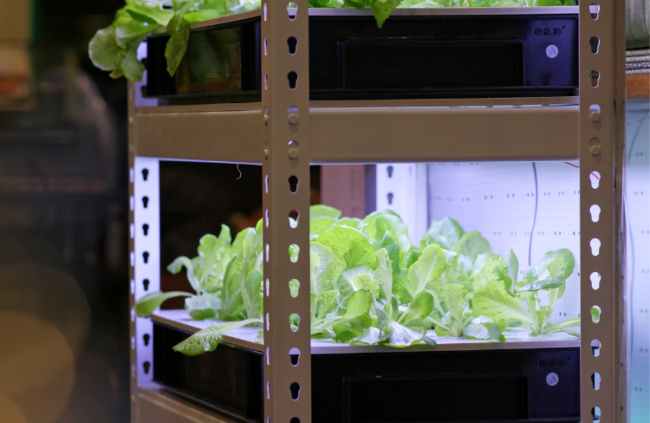
These are just stands and shelves with grow lights. There are no particular specifications to what they look like, how they function, or the sort of interface you’ll have with the lights, timers, etc.
In some ways, that makes choosing one more complicated, but in others, it makes it much easier to separate good grow light shelves and stands from bad ones, just by looking at the coverage of lighting, type of lighting, and the amount of space your plants will have to grow.
So stick with us as we break down exactly why you need a grow light stand or shelf, and just what to look for when choosing the best for your indoor plants and seedlings.
Why You Need an Indoor Growing Shelf
Every plant you grow indoors has one shared challenge – light levels. Regardless of their differing needs for moisture, nutrients, drainage, and container conditions, every houseplant, vegetable seedling, or indoor crop requires sunlight to grow. Our new favourite way to play with that requirement is indoor plant shelves with grow lights.
While it’s possible to grow most plants indoors, you’ll need a room that matches their light requirements, and that’s not always possible. It’s also challenging to start any seedlings indoors for most of us because our brightest windows are often in front of kitchen counters or furniture.
Using grow light shelves means you can start your seeds and cuttings in any room in the house by managing their light levels electronically and keeping an eye on soil moisture – with some indoor plant shelf users even setting them up in basements!
What to Look for When Buying Indoor Plant Stands and Shelves with Grow Lights
Grow light shelves and stands are very, very varied, but grow lights themselves have a few basic specs that will help you decipher which shelves will be useful, and which are simply style over substance.
In the reviews, we purposely chose a mix of attractive but functional shelves and stands, to show that you don’t necessarily need to compromise on looks to have an effective indoor growing setup.

Grow light type and spectrum
The most important thing to check is whether your lights are full spectrum. Full spectrum just means that a light emits an even mix of colours to mimic sunlight. UV lamps are different, and while better, burn hotter, and are much less energy efficient.
Full spectrum lights can be easily differentiated on wattage too. For example, a full indoor grow setup for tomatoes would realistically require a 600W full spectrum light as a minimum (some can change between red and blue for different growth stages, but it’s not 100% necessary).
However, for seedlings, and boosting existing sunlight, even a basic 200W grow light is enough.
Materials
Timber, metal, and plastic indoor grow light shelves are all out there to buy, but I personally prefer metal. Some homeowners will like the look of timber more, but that’s up to you.


Get Your Free Guide:
Master Growing Australian Natives eBook
A Must Have Complete Guide for Every Australian Garden
Get Your Free Guide:
Master Growing Australian Natives eBook
A Must Have Complete Guide for Every Australian Garden
The important thing is to consider how your plants will drain, whether they’ll be placed on drip trays, or if you’ll water them elsewhere.
Once you’ve got your head around caring for the shelf as well as the plant, it’s really just down to design.
Space and size
My main consideration when buying our indoor grow shelf was size and space, because we’ve not got a big house, and we wanted to increase our seedling setup, purely to grow annuals and biennials indoors before planting them out in spring.
We went for a set of metal shelves that was about 1.5 m wide, with four tiers. The top tier didn’t have grow lights, so we used that for storing watering cans and compost, but the lower tiers allowed for five 30 cm seed trays on each shelf – giving us enough space to start fifteen trays of seed (a mix of veggies and annual flowers.
For house plants, just make sure you’ve got about 30 cm of space around each semi-mature pot, and they should be fine.
Different Types of Indoor Grow Light Shelves
While most growing shelves can only be differentiated by looks, there are a few stand-out (if slightly more expensive) types out there, including designer grow light shelves and even hydroponic grow light shelves.
Many of the more practical types are also trolleys, or shelves on castors, which can be moved around easily to clean, tidy, or wipe up spills.
Decorative grow light shelves
Static, decorative indoor grow light shelves are packed with character, and designed to fit well in most homes. Some are a little bit out there in terms of shape and size, but most are quite discreet but impeccably stylish, and add as much joy to your home through looks as they do through practicality.
Hydroponic grow light shelves
They might be more expensive, but they’re also infinitely more practical. If you’ve got a north-facing apartment, and nowhere to grow veggies, salads, or herbs at home, you can use a simple hydroponic shelf, with built-in grow lights, to grow all the salads you could possibly need.
With basic coir-filled pods, seeds can be sown directly, or in trays under the lights, then transplanted into pods before turning the hydroponic system on.
Once set up, you’ll have a self-watering, self-lighting, planter that tends to your plants for you and gets around the problems of any shady home.
(Also see our in-depth beginners' guide for growing with hydroponics to see if its the better option for you.)
Grow light trolleys
Houseplants, seed trays, and veggies are all pretty tidy things to keep indoors, but they do spill, and they will occasionally create a mess – particularly if you tend to them, weed them, etc. indoors.
If you’re at all worried about that, it’s worth considering an indoor grow trolley instead. Simply because they can be moved easily to sweep, vacuum, or mop up any drips, soil spills, or other mess, and help to keep your home tidy.
How to Use Grow Light Stands and Shelves
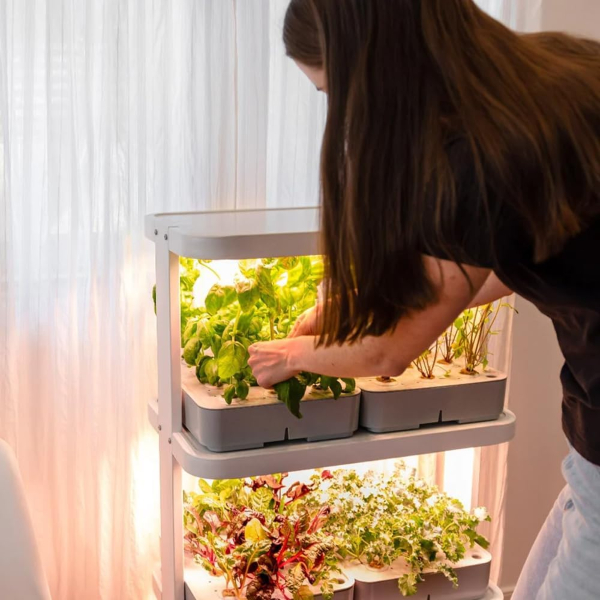
Indoor plant stands and shelves with grow lights are really simple to use, but a few have quite intricate lighting systems, with timers, pre-set routines, or chains of wiring that need setting up.
Before placing any plants on them, make sure you’ve got the whole thing set up, with grow lights (if separate from the structure) set up and working in a string.
Once your plants or seed trays are in place, if the lights have timers or dimmers, adjust them to your needs, and then all you need to do is water when they need it.
Grow Light Plant Shelf and Stand Reviews
1. Bstrip 4-Tier Indoor Plant Shelf with Grow Light

While it’s not the most exciting-looking indoor plant shelf in the world, it is probably the most practical. With 12 full spectrum grow lights, you can place and adjust them easily on the steel framed shelves, which allow water to drain and are equally sturdy enough to hold drip trays and up to 20 kg per shelf.
We’ve got something similar here, and it’s one of the most useful bits of garden kit we’ve ever bought.
Pros
Cons
2. Solatmos Wood Plant Stand With Grow Lights

If you’re trying to make a dark corner of your home feel bright and airy, or attempting to bring a feeling of the outdoors in, then the Solatmos plant stand is definitely the one for you.
With space for dozens of young plants, seedlings, or eleven mature house plants, this timber-framed indoor grow light shelf is as beautiful as it is useful.
It’s also really simple to assemble, and while the grow lights are basic, they are full spectrum, so will adequately support any houseplants in low light, or indirect light conditions.
Pros
Cons
3. Solatmos Metal Grow Light Stand
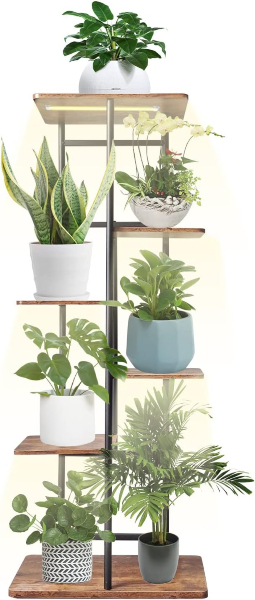
With five tiers, and five grow lights, this gorgeous decorative indoor grow light shelf from Solatmos is a good-looking addition to any home, and definitely best used to show off houseplants.
Its sturdy metal frame and varnished timber shelves are well weighted, but look feather-light, offering a space-saving, and airy solution for any indoor gardeners trying to add more to their collection.
The grow lights are on a string with a simple timer to provide automatic light cycles too, which makes plant care completely idiot-proof.
Pros
Cons
Indoor Plant Shelves Top Picks for 2025
Top Rated Indoor Plant Shelf with Grow Lights


Bstrip’s 4-Tier Plant Shelf is the most practical, and cost-effective indoor plant shelf. It’s easy to assemble, easy to use, and offers effective lighting for all stages of plant growth.
While the lights aren’t exactly hydroponic-worthy, they are more than enough to support seedlings and mature salad crops, or any houseplants that need a boost. Plus, with castors included, the whole setup can be moved around the house or shifted to clean around, making it a great all-round addition to any home.
Best Value Grow Light Plant Stand


For indoor gardeners on a budget, Solatmos offers a gorgeous timber-framed plant shelf that can be adjusted to suit most spaces, and put together in a few different formats (each with instructions included).
The only downfall, and where the cost savings come in, is that it is supplied with just five grow light strips. And while they are effective full spectrum lights, it can be a struggle to orientate them to get the best coverage for all your plants.
Grow Light Stands and Shelves FAQs
How do you arrange indoor plants on a shelf?
When arranging indoor plants on a shelf, you should try to keep the taller plants at the back, and shorter plants to the front. It’s simple, but important, ensuring all plants have good air circulation.
Additionally, you should try to keep some space between each pot and aim to keep the foliage of each plant from touching its neighbour.
What is the best type of indoor grow light?
For serious indoor growers, looking to harvest multiple crops from seed to maturity, 600w grow lights are the most efficient use of space and energy, and are generally able to support several metres squared of indoor pots.
However, provided a light is full spectrum, it will support the growth of most plants.
Where should indoor grow lights be placed?
Low-wattage (under 100w) grow lights should be placed within 50 cm of a plant. Closer than 10 cm and the light may be too bright, but anything from around 15-50 cm away from the top of the plant is sufficient to provide good coverage.
How many hours should I leave my grow lights on for indoor plants?
The summer daylight cycle for most outdoor plants is 16-18 hours. Mimicking that with your indoor lights is the best way to speed up their growth and mimic nature, but many will survive with as little as 6-8 hours of direct full spectrum lighting per day.
For bigger growing projects, you might want to look into our product review and buying guide for choosing the best growing lights available today.
Wrapping Up Our Guide for Choosing the Best Grow Light Stands and Shelves
If you’re considering an indoor plant shelf with grow lights, you’re probably doing it for a reason. Whether that’s to increase your yields, boost your growing space, or troubleshoot indoor growing problems, from low lights to poor temperatures.
Whatever your reason, one of the indoor grow light shelves above will do exactly what you need, and make sure you can grow what you want, when you want on any budget.
Published on June 30, 2023 by Gary Clarke
Last Updated on December 23, 2025


